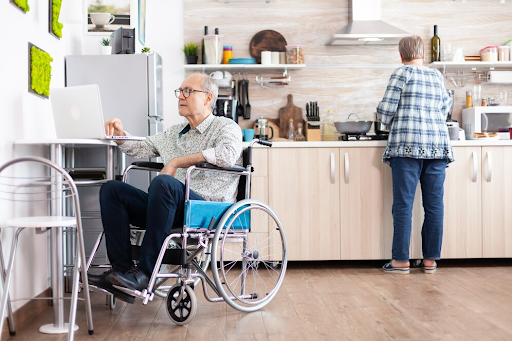5 minute read
In today’s world, ensuring that our homes are accessible to everyone, including those with mobility challenges, is becoming increasingly important. Whether you have a family member who uses a wheelchair or you are planning for the future, making your home wheelchair-accessible benefits everyone. In this blog post, we will explore what you need to consider when making your home more accessible. From understanding the needs of wheelchair users to assessing your current home and implementing changes, we’ve got all the information you need.
Understanding Accessibility Needs
When considering how to make your home more accessible, it is essential first to understand the diverse needs of wheelchair users. People with mobility impairments face various challenges that can impact their daily lives, from navigating tight spaces to reaching high shelves. Recognizing these challenges is the first step toward creating a more inclusive environment.
Some individuals may have limited upper body strength, making it difficult to open heavy doors or windows. Others might use powered wheelchairs that require wider pathways and doorways. By understanding the range of mobility impairments, you can better cater to the specific needs of wheelchair users.
Every person’s needs are unique, so it’s crucial to tailor solutions to individual circumstances. Consulting with an occupational therapist or accessibility expert can provide valuable insights into creating a space that suits the specific requirements of its occupants.
Assessing Your Home
Before making any modifications, it’s essential to conduct an accessibility assessment of your home. This process helps identify areas that need improvement and ensures that the modifications you make will be effective. Here’s a checklist to get you started:
Entrances: Are there steps leading to your front door? Consider installing a ramp or lift.
Doorways: Measure the width of your doorways. They should be at least 32 inches wide to accommodate most wheelchairs.
Living Areas: Ensure there is enough space to maneuver a wheelchair in common areas like the living room, kitchen, and bathroom.
Take note of any potential obstacles, such as narrow hallways, steep stairs, or high thresholds. Assessing your home thoroughly will give you a clear picture of what needs to be changed.
Home Modifications
Once you’ve assessed your home, it’s time to start making modifications. Here are some common adaptations that can make a significant difference in accessibility:
Installing Ramps and Lifts
Installing ramps and lifts is a fundamental step in enhancing home accessibility. Ramps provide a smooth transition over steps and can be installed at entrances or within the home. It’s crucial to ensure the slope is gentle enough for easy navigation. An elevator lift, on the other hand, offers a practical solution for multi-story homes. These lifts can accommodate wheelchairs and reduce the physical strain of using stairs. When choosing between a ramp and an elevator lift, consider your specific needs, available space, and budget to make the best decision for ensuring seamless mobility throughout the home.
Widening Doorways
Narrow doorways can be a significant barrier for wheelchair users. Thus, widening doorways is crucial for creating a wheelchair-accessible home. Standard doorways are often too narrow for wheelchairs, making navigation difficult and unsafe. By expanding doorways to at least 32 inches, you allow for smoother and more comfortable movement. This adjustment not only provides ease of access for wheelchair users but also benefits others, such as parents with strollers or individuals moving furniture.
Adjusting Countertop Heights
Adjusting countertop heights in kitchens and bathrooms is another vital modification for accessibility. Standard countertops are often too high for wheelchair users to reach comfortably. Lowering countertops or installing adjustable-height counters can make these spaces more functional and user-friendly. This change enables wheelchair users to cook, clean, and carry out daily activities with greater independence and ease.
Technology and Innovations
Technological advancements have made it easier than ever to create accessible homes. Here are some innovations that can enhance accessibility:
Smart Home Devices
Smart home technology can significantly improve the quality of life for wheelchair users. Voice-activated assistants like Amazon Alexa or Google Home can control lights, thermostats, and other devices, reducing the need for physical interaction.
Assistive Technology
Various assistive devices can help individuals with mobility impairments lead more independent lives. Examples include automatic door openers, stairlifts, and specialized kitchen appliances designed for one-handed use.
Legal and Financial Considerations
Making your home accessible is not just a moral obligation; it’s also a legal requirement in many places. Familiarize yourself with local building codes and regulations to ensure your modifications comply with the law. Additionally, several financial assistance programs are available to help offset the costs of making your home more accessible.
Legal Requirements
Different regions have specific guidelines that must be followed when modifying a home for accessibility. These regulations often cover aspects like ramp inclines, door widths, and bathroom accessibility standards.
Financial Assistance
Renovating your home to be wheelchair accessible can be expensive. Fortunately, there are grants, loans, and tax incentives available to help. Research local and federal programs that provide financial assistance for accessibility modifications.
Creating an accessible home is not just about meeting legal requirements; it’s about fostering an inclusive environment where everyone can thrive. By understanding the diverse needs of wheelchair users, assessing your home, making necessary modifications, and leveraging technology, you can make a positive impact on the lives of those with mobility challenges.
Ready to start making your home more accessible? Begin by conducting a thorough assessment of your current space. Research financial assistance options and consult with experts to ensure your modifications are effective and compliant with local regulations. Share your experiences and questions with our community to inspire others on this important journey. Let’s work together to create homes that are welcoming and accessible for all.





